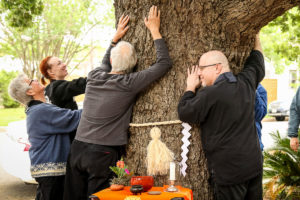- Monday, April 22, 2019 at 6pm
Ceremonial Expression of Commitment to our Mother the Earth
 Join us on Monday April 22nd for our EARTH DAY CEREMONY at 6:15 pm. The ceremony will take place outdoors and will consist of several parts:
Join us on Monday April 22nd for our EARTH DAY CEREMONY at 6:15 pm. The ceremony will take place outdoors and will consist of several parts:
First, the assembly will have the opportunity to write words of gratitude, intention, and vow with regard to our commitment to our Mother the Earth on paper ‘ema,’ or plaques. Blank plaques will be available during the days approaching the ceremony, so please stop by beforehand to offer an intention, even if you cannot make it to the ceremony itself.
Following a ritual purification of the space, we will offer bows, incense, and chanting of an excerpt from Dogen Zenji’s Mountains and Rivers Sutra – during which time the ema will be ceremonially hung from the great oak in the front yard. The oak tree, which was symbolically ordained in 2014, reminds us of our unfathomable and absolute mutual interconnection with all things, and specifically that nature greatly deserves and needs our utmost respect, care, and stewardship.
Interested in participating in pre-ceremony preparations? Join us at 5pm on Monday eve before the Earth Day Ceremony to help prepare the Shimenawa and Shide seen in the photo above.
Where: Austin Zen Center
3014 Washington Square
Austin, TX 78705
www.austinzencenter.org
Donations will be gratefully received
AZC is a not-for-profit that relies on the generosity of its members & supporters
Question: What is the significance of the rope tied around the large Post Oak tree and the zig-zag paper strips hanging from it?
Answer: The Austin Zen Center is a Soto Zen Buddhist temple with roots in Zen, which upon its arrival to Japan became heavily influenced and even interwoven with the dominant Japanese indigenous religion and culture of Shintoism: “the way of the kami.” Shinto is a system of prehistoric nature worship that imbued every mountain, every stream, and even rocks and trees with a
spirit. These deities, known as kami, were considered cheerful and friendly to humans. If kept satisfied, they would watch over human affairs and refrain from causing natural disasters. Many Japanese people practice both Shintoism and Buddhism, and Shinto shrines are often found at Buddhist temples in Japan. The reverence and respect for nature is an integral part of our Zen practice, woven into our life of practice at a basic, almost primordial, level. On Earth Day we hail back to these ancient traditions of deep and sustaining respect, care, and stewardship of our planet Earth and the natural world, both as a manifestation of our Bodhisattva Vows and as acknowledgement of our mutual interconnectedness.
Shimenawa are lengths of laid rice straw or hemp rope used for ritual purification in Shinto. They are believed to act as a ward against evil spirits and are often set up at a ground-breaking ceremony before construction begins on a new building. They are found at Shinto shrines, torii gates, and sacred landmarks and can vary in diameter from a few centimetres to several metres, often festooned with rope tassels and zig-zag paper streamers called shide. A space bound by shimenawa indicates a sacred or pure space.
They are also used around yorishiro (objects capable of attracting spirits and being inhabited by them). Shimenawa ropes surround yorishiro to make their sacredness manifest. These notably include certain trees, in which case the inhabiting spirits are
called kodama, and cutting down these trees is thought to bring misfortune. In cases of stones, the stones are known as iwakura. Hanging white paper shide delineates a sacred space or object, and is an indication that spirits or gods are present.
Don’t Miss the Screening of Nausicaa of the Valley of the Wind (Friday at 6pm)
 Join us on April 20th at 6:00pm for a screening of this spectacular film, written, animated and directed by legendary Japanese filmmaker Hayao Miyazaki. The film depicts the life of a young Princess Nausicaä in a dystopian future set 1000 years after an apocalyptic war referred to grimly as “the Seven Days of Fire” destroyed most of civilization. For Nausicaä and the surviving inhabitants of the Earth, life is dominated by interactions with the ever-growing Toxic Jungle that was spawned in the aftermath of the war. The Jungle and the massive insects that evolved to protect it threaten humankind with extinction as they relentlessly consume the remaining human kingdoms, which are plagued by war and starvation. Confronted with this bleak reality, Princess Nausicaä devotes herself to understanding the mysteries of the Toxic Jungle to see if there is any hope for humanity to coexist with the Jungle and its giant insect guardians. More than 30 years later, “Nausicaä” remains a must-see for anyone with a taste for epic storytelling, quality science-fiction or just film in general. If you limit yourself from seeing this film because you “don’t like anime,” then you are missing out on a true work of art. Although the teachings of the film should resonate strongly with mindfulness and Buddhist practitioners, it is also a wake-up call to our wider community. With the truth of our interconnectedness to each other and Earth so evident in science and the Dharma, are we (especially as Buddhists) appropriately and fully engaged in the transformation to a more life-sustaining approach to civilization? If not us, then who?
Join us on April 20th at 6:00pm for a screening of this spectacular film, written, animated and directed by legendary Japanese filmmaker Hayao Miyazaki. The film depicts the life of a young Princess Nausicaä in a dystopian future set 1000 years after an apocalyptic war referred to grimly as “the Seven Days of Fire” destroyed most of civilization. For Nausicaä and the surviving inhabitants of the Earth, life is dominated by interactions with the ever-growing Toxic Jungle that was spawned in the aftermath of the war. The Jungle and the massive insects that evolved to protect it threaten humankind with extinction as they relentlessly consume the remaining human kingdoms, which are plagued by war and starvation. Confronted with this bleak reality, Princess Nausicaä devotes herself to understanding the mysteries of the Toxic Jungle to see if there is any hope for humanity to coexist with the Jungle and its giant insect guardians. More than 30 years later, “Nausicaä” remains a must-see for anyone with a taste for epic storytelling, quality science-fiction or just film in general. If you limit yourself from seeing this film because you “don’t like anime,” then you are missing out on a true work of art. Although the teachings of the film should resonate strongly with mindfulness and Buddhist practitioners, it is also a wake-up call to our wider community. With the truth of our interconnectedness to each other and Earth so evident in science and the Dharma, are we (especially as Buddhists) appropriately and fully engaged in the transformation to a more life-sustaining approach to civilization? If not us, then who?
